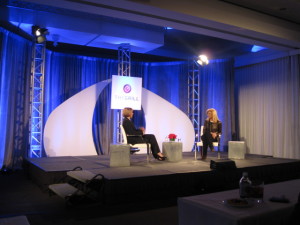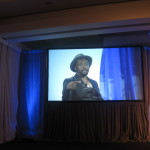 Look around at most entertainment industry, media and technology conferences and you’ll see a familiar sight: a sea of suits–men in suits, with women in the distinct minority.
Look around at most entertainment industry, media and technology conferences and you’ll see a familiar sight: a sea of suits–men in suits, with women in the distinct minority.
That was one of the differentiating factors of TheWrap’s second annual media leadership conference TheGrill, with its theme “Content Rising.”
The brainchild of Sharon Waxman, the editor-in-chief of the nearly three-year-old entertainment news website, the former New York Times reporter moderated many of the panels and one-on-one discussions, including one with another female media powerhouse, AOL Huffington Post president and editor-in-chief Arianna Huffington.
Waxman kicked off the conference, held at the trendy SLS Hotel in Beverly Hills last week, in a keynote session entitled “Hollywood’s Future: Between Wall Street and Silicon Valley” with two media industry heavyweights, Terry Semel and Harry Sloan.
They focused on the changes in the entertainment industry resulting from the decline of revenue from sale of DVDs of television shows and movies and into the world of digital content streaming.
The alliance between entertainment and technology, while still in its infancy, is resulting in increased competition for the type of content that only Hollywood has the ability to produce.
“For those who make and own content, these are good times,” pronounced Semel, the former Yahoo CEO and Warner Bros. chairman, now the chairman and CEO of WindsorMedia.
Semel discussed how tech companies are waking up to the fact that advertisers are looking for stable content that could just as easily be on broadcast or cable. He said it’s possible, but unlikely in the near future that one of the majors like Google, Apple, Netflix or Amazon would buy a studio– although the result would potentially be much more fruitful than AOL’s ill-fated purchase of Time-Warner a decade ago.
“They have a lot of cash, and now they can spend it on real content, acquiring and licensing it. The silly little things are going away,” he said, referring to the often goofy, user-generated videos that were the bread and butter of YouTube as it gained popularity.
Sloan, who formerly ran MGM and is the chairman and CEO of a fund called Global Eagle Acquisition Corp., talked about the huge migration of eyeballs from television to the Internet. He said that 18% of viewers watch television programming digitally while only 5% of TV advertising has moved to the Web, leaving a massive ocean of cash to be tapped.
“We have to figure out where this assault on traditional media by digital media is going,” Sloan said.
“The old debate between distribution and content is over,” contended Semel. “Companies need better content to sell advertising around.” He predicted that Hollywood will soon have four or five more HBO-type entities as customers for their content, referring to the new media companies that need quality content.
Other panels delved into additional hot topics in the industry, ranging from the power of cable television in the digital age, leveraging Facebook for opening weekend, how Pandora is remaking the online music business model and television and film distribution in the age of cloud computing.
“Modern Family” executive producer and co-creator Steve Levitan participated in a one-on-one discussion with Reuters editor Jim Impoco about the power of content on television and how there needs to be a better way of measuring viewers on emerging platforms.
“I worry about a time, if the [ratings] system is not kept current, that old-fashioned shows that appeal to traditional viewers have an advantage over shows like mine that appeal to younger, tech-savvy viewers,” said Levitan, who had just won a slew of Emmy awards for the ABC comedy. “There are a number of new, amazing ways to see our show now, and I don’t particularly care how people watch it. All I ask as a creator is that every pair of eyeballs is counted. We’re judged by that number.”
In a session called “Can a News Blog Transform a Portal? The New AOL Huffington Post,” Waxman asked Huffington if she had seller’s remorse after receiving $315 million for the portal fromAOL earlier this year.
Huffington said no, remarking that 24 sections including Style and Weddings have been added to HuffPo and that the growth– including expansion to international territories– would’ve been impossible without AOL.
“My dream was to grow in multiple ways at the same time, but we didn’t have the resources available to do that before. All of these new launches we wanted to do would have taken years,” she said.
Huffington quashed rumors about AOL merging with Yahoo, and discussed recent developments with Patch, TechCrunch and MovieFone.
The confab culminated in Waxman’s and Om Malik’s wide-ranging talk with founder and front man of The Black Eyed Peas, will.i.am.
The tech-savvy musician, who grew up in government-subsidized housing in the Boyle Heights section of Los Angeles, but went to school in affluent Pacific Palisades, lambasted American cultural and educational institutions for failing to inspire disadvantaged youth to enter careers in science, math and technology.
“They all want to be Jay-Z, Kobe or Beyoncé,” he said, while advocating that being an engineer at Boeing or Google is a rewarding life and that given a choice he would rather be Twitter founder Biz Stone than Jay-Z and that he would take Google over Interscope.
“Smartphone makers are pushing to make sure their chips are the fastest in the world, but no one is pushing our kids to be the fastest in the world,” he said. “Why aren’t our kids learning about education and science?”
The seven-time Grammy winner noted that many schools in poor neighborhoods do not have science labs, but that they all seem to have football fields and basketball courts.
In an effort to shine a light on “geeky” careers, will.i.am teamed up with Segway inventor Dean Kamen’s FIRST (For Inspiration and Recognition of Science and Technology) and executive produced and self-financed the youth-targeted documentary “I.am FIRST: Science Is Rock and Rollm” and said he sold ads to purchase the airtime for it to run on ABC last month.
It aired August 14 and featured the Justins, Timberlake and Bieber, along with Bono, Britney Spears, Miley Cyrus, Snoop Dogg and Steven Tyler—all of whom sung the praises of scientific and technological endeavors. Naturally, the Peas performed, as did Willow Smith.
Will.i.am attributed his activism to working on President Barack Obama’s 2008 campaign, during which he produced the music video “Yes We Can.”
“Obama changed me by reminding me how I could support my community,” he said, and that he advises people to change their thoughts and align them with their dreams in order to change their communities.


